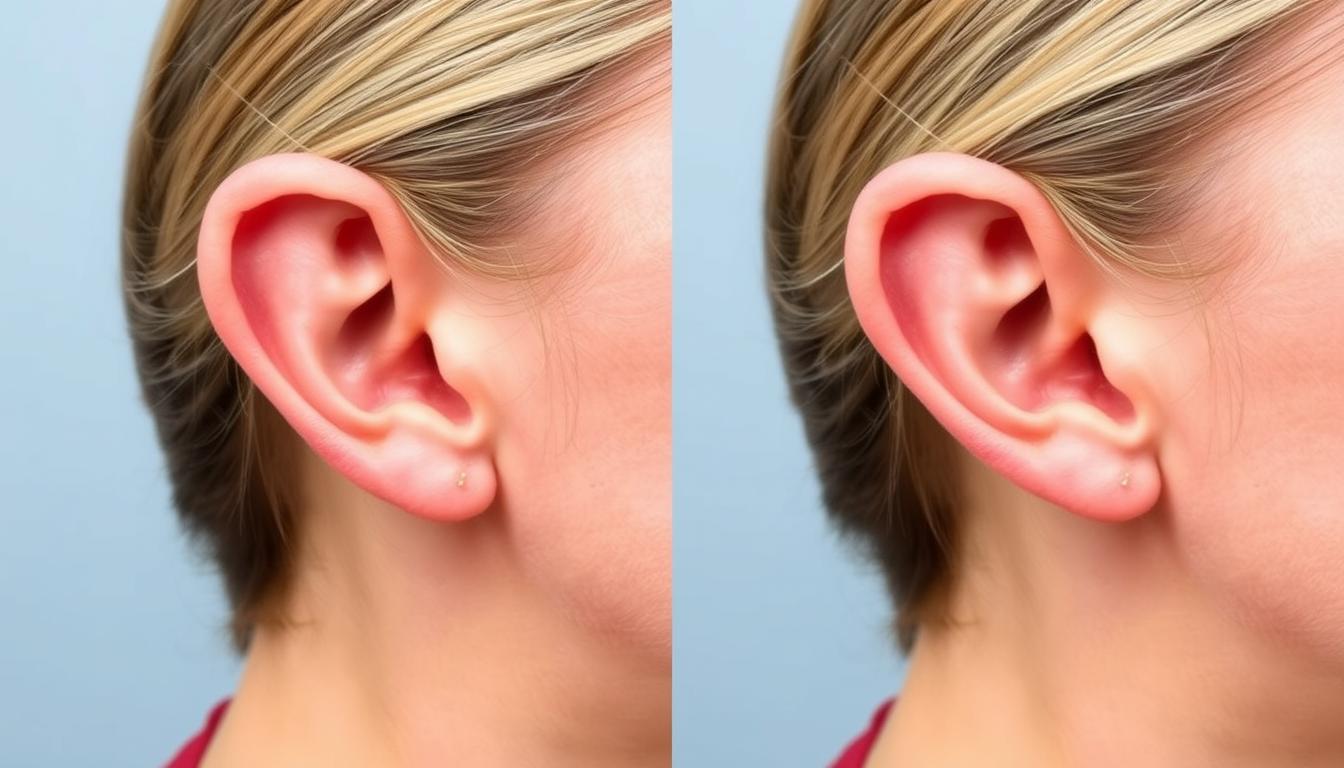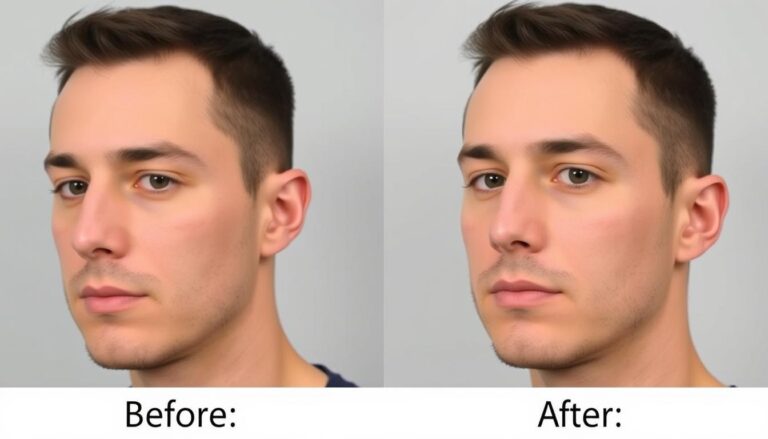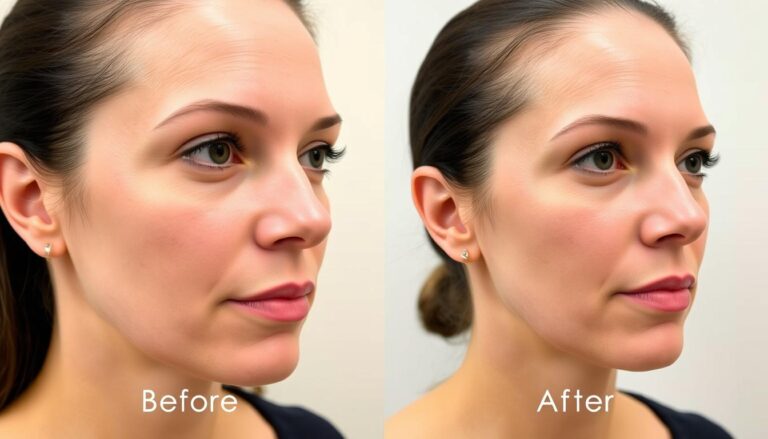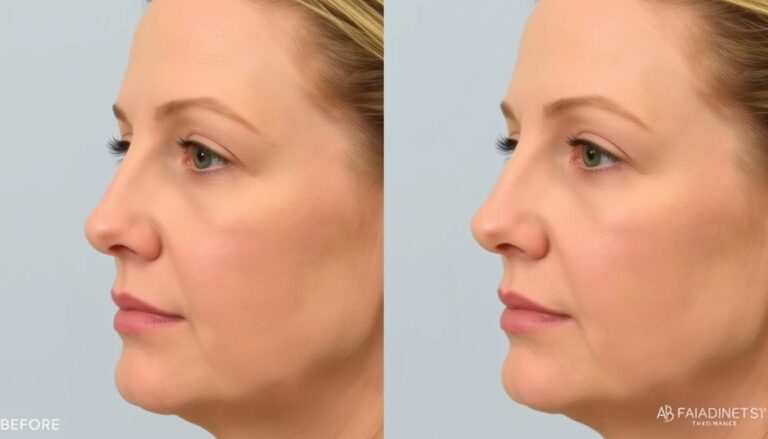Otoplasty Before and After: Realistic Results

Did you know about 5% of people worldwide have ears that stick out? This makes otoplasty, a surgery to fix ear shape and size, very common. It can change someone’s life, boosting their self-confidence by up to 92% in kids aged 5 to 16.
We’ll look into otoplasty, focusing on what you can expect before and after. Real pictures show the amazing results patients get. These images help set clear expectations and show off the talent of plastic surgeons.
Choosing the right surgeon is key. We’ll talk about why and what the whole process is like. Let’s explore how otoplasty can change lives for the better.
Table of Contents
What is Otoplasty?
Otoplasty is a surgery that makes ears look better. It boosts self-confidence for many. It fixes issues like ears sticking out too much or being the wrong size.
Definition of Otoplasty
This surgery changes the look of the outer ear. It makes ears less noticeable by moving them closer to the head. It also changes size and shape for better balance. Each surgery is custom-made for the patient’s look.
Purpose of the Procedure
Otoplasty makes ears look more even and balanced. It helps people feel less self-conscious about their ears. Otoplasty before and after photos show how much it can change someone’s look.
It’s especially good for kids. The best time for it is when they’re about five. Kids often feel embarrassed about their ears. Looking at cosmetic ear surgery pictures can show what’s possible.
| Aspect | Details |
|---|---|
| Typical Cost | $3,000 to $8,000 |
| Recovery Time | Initial healing: 1 to 2 weeks; Full recovery: months |
| Recommended Post-Op Care | Avoid swimming for 4 to 6 weeks |
| Surgery Duration | Approximately 2.5 hours |
| Typical Patient Age | At least 5 years old |
Who Needs Otoplasty?
Otoplasty is key for those with ears that stick out too much. It helps boost confidence and makes facial features look better. Both kids and adults can see big changes with otoplasty results.
Individuals with Prominent Ears
Big ears can make people feel shy and anxious. Otoplasty moves ears closer to the head, making them less noticeable. It helps those with Stahl’s ear or cupped ear feel more confident. The before and after ear pinning show how much of a difference it makes.
Children and Adults
Otoplasty can be done on kids as young as five. It’s especially common for kids aged 4 to 14 to avoid bullying. By age five, ears are almost as big as they’ll be as adults, making it a good time for surgery. Adults also get it to fix big ears or improve facial balance, often using sedation for comfort.
People of all ages can talk to experts about otoplasty for a more balanced look. For more on ear issues or health, learn more to feel better about yourself.
The Otoplasty Procedure
Learning about the surgery can make you feel less nervous before it starts. Otoplasty fixes ears that stick out too much, making you look and feel better. It includes steps like choosing anesthesia and how long the surgery lasts.
Overview of the Surgical Process
The first step is a detailed talk with the surgeon. They mark where they will work on your ears. Then, they make small cuts behind your ears to hide scars.
The exact steps depend on what you want. You might want your ears to look smaller or more even. After the surgery, many people see a big change in how they look, which makes them feel more confident.
Anesthesia Options
You can choose how you’ll be numbed during the surgery. You can pick local anesthesia, which just numbs your ears, or general anesthesia, which makes you sleep. Your choice depends on what you’re comfortable with and what the doctor suggests.
Duration of the Procedure
The surgery usually takes one to two hours. This time lets the surgeon make sure everything is just right and safe for you. After the surgery, you’ll need about seven days to rest and get back to normal. Knowing this helps you get ready for what’s coming.
| Aspect | Details |
|---|---|
| Age Range for Surgery | Children as young as six; performed mostly on adults |
| Recovery Time | Approximately seven days |
| Surgical Complexity | Affects pricing; higher complexity leads to higher costs |
| Common Reasons for Otoplasty | Macrotia or protruding ears |
| Impact on Hearing | No effect on hearing |
Knowing these details helps clear up any confusion about otoplasty. It gives you a better idea of what to expect from start to finish.
Pre-Treatment Care
Before getting otoplasty, it’s key to prepare well. This means having a detailed consultation with a skilled specialist. They will guide you through what you need to do. Knowing how to prepare can make your surgery go smoothly.
Consultation with a Specialist
Talking to a board-certified plastic surgeon is crucial. They will look at your medical history and do a physical check. They’ll also see if otoplasty is right for you.
This meeting helps plan for what you’ll need after surgery. It’s a chance to see how things might look and learn about the process.
Health Assessments and Testing
You might need health checks and tests before surgery. These could be lab tests or an EKG, based on your health history. These steps make sure you’re ready for surgery.
Looking into an otoplasty cost estimator can help with planning your budget. It shows what you might spend on care before and after surgery.
Medication to Avoid
Talk about your medications before surgery. You should stop taking blood thinners like aspirin and ibuprofen two weeks before. This reduces risks during surgery.
Following these guidelines is important. It helps ensure your surgery goes well and you have the best results.
Otoplasty Before and After Pictures
Looking at real before and after pictures is key for those thinking about otoplasty. These images give a clear view of what cosmetic ear surgery can do. They help patients know what to expect from their surgery.
Importance of Visualizing Results
Looking at the best otoplasty photos can show how well the surgery works. Results vary because of different body types and how the surgery is done. Seeing these pictures can make people feel less worried and understand what they might look like after.
Where to Find Authentic Photos
Real before and after photos are often found on certified plastic surgeons’ websites. These sites show many pictures of real patients. This helps people make choices based on what others have gone through.
| Source | Type of Photos | Example Results |
|---|---|---|
| Surgeon’s Website | Before and After | Varied Results Based on Anatomy |
| Patient Testimonials | Personal Experiences | Realistic Transformations |
| Social Media Platforms | Informal Sharing | Widely different perspectives |
Post-Treatment Care
After otoplasty, taking good care is key to the best results. Knowing how long it takes to recover helps set realistic goals and ensures a smooth healing.
Immediate Aftercare Instructions
In the first few days, focus on managing pain and swelling. Here are some steps to follow:
- Keep your head elevated to minimize swelling.
- Apply cold compresses to the area as needed.
- Take prescribed medications for pain management.
- Avoid touching or pulling at the ears.
- Follow any specific instructions provided by your surgeon.
Long-Term Care Recommendations
As recovery moves to long-term care, keeping the surgical area clean is crucial. Follow these recommendations:
- Attend follow-up appointments to monitor healing progress.
- Avoid strenuous activities for at least 2 weeks.
- Stay out of direct sunlight for approximately 6 weeks.
- Report any unusual signs such as excessive swelling or discomfort to your surgeon.
The recovery time for otoplasty is usually about 6 weeks. But, everyone’s experience is different. Knowing this helps plan your schedule after surgery, including time off from work or school.
Risks and Complications
Otoplasty, like any surgery, comes with risks. Knowing these risks helps patients prepare and make smart choices. Most people get good results, but it’s key to know possible problems that might happen during or after the surgery.
Common Risks Associated with Otoplasty
Here are some risks of otoplasty:
- Infection, a common risk in any surgery.
- Asymmetry, which may affect the aesthetic outcome.
- Scarring, although most cases involve minimal scarring.
- Allergic reactions to materials used during the operation.
- Bleeding, which can occur during or post-surgery.
- Possible numbness, which is typically temporary and resolves in a few months.
- Keloid scars for patients with a history of poor scarring.
Signs to Watch For
After otoplasty, watch your healing closely. Look out for:
- Excessive swelling beyond what is expected.
- Unusual pain levels that do not subside with medication.
- Any changes in sensation around the ears.
- Abnormal discharge from incision sites.
If you notice any concerning symptoms, talk to your surgeon right away. While serious problems are rare, acting fast ensures the best outcome.
Knowing the risks of otoplasty is important. Talk to your surgeon about these risks during your consultation. For more on recovery, like using knee braces, check out orthopedic knee brace options.
Products Recommended Pre and Post Treatment
Choosing the right skin care products is key for a smooth healing after otoplasty. Look for skin care products to use that are gentle and fragrance-free. These products help keep your skin healthy without causing irritation.
Skin Care Products to Use
Before and after surgery, use specific skin care products to ease discomfort and aid recovery. Recommended items include:
- Gentle cleansers to avoid irritation on sensitive skin.
- Moisturizers that help keep the skin smooth and hydrated.
- Antibacterial ointments such as bacitracin to apply on incision lines for protection.
Following these recommendations can greatly improve your recovery. It ensures your skin stays healthy, reducing the chance of complications. This way, you can recover efficiently.
Bandages and Other Medical Products
Medical products are also vital for post-operative care. You will typically get:
- Specialized bandages to cover the surgical sites, which should remain in place for at least a week.
- A loose headband to wear consistently for 2 to 6 weeks, which will help maintain ear positioning and reduce swelling.
- Prescription pain medication and antibiotics to support the healing process.
Using these medical products correctly is crucial for good results. It affects how well the procedure works. For more on recovery, check out sandals for plantar fasciitis. Comfort during recovery is important, not just surgical care.
Alternative Treatments to Otoplasty
If you’re not ready for surgery, there are other ways to change your ear’s look. Non-surgical methods can make small but noticeable improvements. They offer a chance to boost your confidence and self-esteem without surgery.
Non-Surgical Options
Non-surgical ear reshaping is becoming more popular. It’s a way to change your ear’s look without surgery. Here are some methods:
- Filler Injections: Dermal fillers can make your ears look fuller or more defined, giving quick results.
- Ear Molds: Soft molds can be worn on your ears to slowly change their shape, making them look better over time.
While these methods work, remember they’re not permanent. You might need to get them done again to keep the look. This makes them good for those who don’t want surgery.
Cosmetic Alternatives
There are also cosmetic options for small changes. Techniques like:
- CoolSculpting: This method can reduce fat around your ears, making them look better.
- Ultherapy: A non-surgical ultrasound treatment that tightens skin can also improve your ear’s look.
These cosmetic options can help, but they might not change your ears as much as surgery. Think carefully about what you want before choosing.
Cost of Otoplasty
The cost of otoplasty is a big factor for those thinking about it. It’s important to know what the procedure costs and what affects these prices. This knowledge helps in making smart choices.
Average Price Range
In the United States, otoplasty usually costs between $3,700 and $5,000. In places like Beverly Hills, it can go up to $9,000. Many things, like where you live and how complex you want the results to be, affect the price. Using an otoplasty cost estimator can help you see different price options.
Factors Affecting Cost
Several things can change how much otoplasty costs:
- Surgeon’s expertise and reputation
- Location of the surgical facility
- Type of anesthesia used
- Complexity of the procedure
- Facility quality and operational expenses
- Supplemental procedures if required
- Pre-operative consultations and post-operative care
It’s a good idea to look at prices from different places and ask about payment plans. Most insurance doesn’t cover otoplasty because it’s seen as cosmetic. But, some cases might be covered. Always get a detailed quote that includes everything, like anesthesia and facility fees. This way, you can plan your budget better for this life-changing surgery.
Finding Otoplasty Near You
Finding a good otoplasty surgeon is key to getting the results you want. Do your homework to compare and choose wisely. Look for board-certified plastic surgeons with lots of otoplasty experience. Online platforms and medical review sites can help you find trusted doctors.
How to Locate Qualified Surgeons
Here are steps to find qualified surgeons:
- Ask family, friends, or your doctor for recommendations.
- Check official websites for surgeons’ credentials and specialties.
- Meet with them to see if they’re a good fit.
Researching Local Clinics and Reviews
It’s important to look into local clinics and read reviews. Reviews can give you a real idea of what to expect. Look for feedback on recovery, results, and overall happiness with the surgery. This helps you compare ear surgeries better.
Start by looking at patient-centered therapy practices. They focus on personalized care, which is key for great results.
Patient Testimonials
Hearing from those who have had otoplasty gives us valuable insights. They talk about how it has changed their lives. Many say it boosted their self-esteem and made them feel more confident.
Patients share their stories, showing why they chose the surgery. They also talk about the amazing results they got.
Real Stories from Those Who Underwent the Procedure
People are thankful and excited after the surgery. They love their new look and feel more at ease in social situations. This change has brought them a lot of happiness.
Feedback on Results and Recovery
Recovery times vary, but most say it was quick and painless. They appreciate the clear aftercare advice from their doctors. The results are worth the temporary discomfort.
Many are happy to show off their ears without worry. This newfound freedom is a big part of their happiness.
Preparing for Your Otoplasty Consultation
Getting ready for your otoplasty consultation is important. You should prepare a list of questions for your surgeon. This helps you understand the procedure, what to expect, and how to recover. Talking about this ensures your goals match the possible outcomes, especially when looking at otoplasty before and after images.
Questions to Ask Your Surgeon
Before your consultation, think about asking these questions:
- What techniques do you recommend for my specific situation?
- What are the potential risks and complications associated with the surgery?
- How long is the expected recovery time?
- Can you show me some otoplasty before and after examples?
- What kind of aftercare will I need post-surgery?
Information to Bring with You
Having the right information makes your consultation smoother. Make sure to bring:
- Your medical history and any past surgeries.
- A list of current medications, including over-the-counter drugs and supplements.
- Any previous treatment records related to ear concerns.
This preparation helps in discussing your needs. It also increases the chance of getting the results you want, like those in otoplasty before and after cases.
The Importance of Realistic Expectations
Before getting an otoplasty, it’s key to have realistic hopes. Knowing that results can differ based on your ear shape and healing is important. Talking with your surgeon about what’s possible is crucial.
Looking at before and after photos can give you a good idea of what to expect. It helps you see the changes you might see.
Understanding Potential Outcomes
Looking at the best otoplasty photos can help you understand what to expect. This way, you and your surgeon can work together to set realistic goals. Remember, every person is different, and many things can affect the outcome.
The surgeon’s skill and your health are also important. They can make a big difference in how well the surgery goes.
Setting Goals for Your Surgery
Talking with your surgeon about what you want is important. This way, you both have the same idea of what you want to achieve. Setting realistic goals helps you heal better and feel more confident.
It’s all about being happy with yourself and what the surgery can do. Focus on what’s possible, not on perfection.
FAQ
What is otoplasty?
What are the benefits of otoplasty?
How is the otoplasty procedure performed?
How long is the recovery time after otoplasty?
Where can I see otoplasty before and after photos?
What are the risks involved with otoplasty?
Are there non-surgical alternatives to otoplasty?
How much does otoplasty typically cost?
What should I expect during the consultation for otoplasty?
How can I choose the right otoplasty surgeon?
How do I care for my ears after otoplasty?
What factors affect the results of otoplasty?
What skin care products should I use after otoplasty?
How soon can I return to normal activities after otoplasty?
Can I see patient testimonials about otoplasty outcomes?







